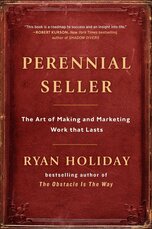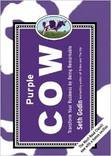 I've been a big fan of Ryan Holiday's work for almost a decade now. I purchased his book Perennial Seller: The Art of Making and Marketing Work that Lasts a while ago and finally got around to reading it recently. I was pleasantly surprised by how widely applicable its content is; I thought initially it would be focused more on books/written work, but it covered so many other fields beyond that including entrepreneurship/business in general as well as other fields like music and design. I liked how it built off the idea of the Lindy Effect (which I first learned about in Antifragile, another book I love and learned so much from), which explains how classics grow stronger with passing time. My biggest takeaway was, "Great things are timeless and take time" and to be patient and focus on the long term. My second biggest takeaway was that if you invest some amount of time and effort in building and creating, you should invest at least as much time and effort into marketing and promoting and giving your work the best chance possible. Overall, it was another very enjoyable, educational, and inspiring book by Ryan Holiday, and I highly recommend it. Below are some more of my notes and takeaways.
0 Comments
 Introduction The third selection of Half Half Man’s Book Club was Seth Godin’s Purple Cow: Transform Your Business by Being Remarkable. I read this book originally in February 2011 and quickly understood why this was such a classic marketing text. While its primary target is new product development, a magician’s act (as well as his or her style and character) can be considered products too, and many of the lessons from Purple Cow carry over directly. The title of the book comes from the idea that when you first drive to the countryside, cows look pretty cool. After a while, cows start to look pretty boring. However, a purple cow would be pretty remarkable, even after seeing normal cows for a while. It’s sad but true: Magic too can get boring sometimes. The art that is most fundamentally defined by the unexpected and impossible can be made to seem banal and commonplace when approached without the care and thought it deserves -- in short, when it’s unremarkable. If the audience doesn’t care, if it’s something they’ve seen many times before, or if it fits with stereotypes of how magicians are perceived (flashy costumes, cheesy lines, etc.), it becomes a much less interesting white cow. The four key Purple Cow principles can be leveraged to break that tendency: Don't be boring (be remarkable) Safe is risky (appeal to the edges, not the masses) Design rules now (focus on design, not marketing) Very good is bad (be remarkable) Don't be boring (be remarkable) The first step in becoming remarkable is to objectively determine your current level of appeal to the audience (boring or engaging). Trusting your own subjective opinion is not going to be enough, as most of us err either on the side of being too haughty or too harsh on ourselves, and it’s only with some sizable sample of audience testing that one can hope to reach any level of objective assessment of skill or remarkability. Godin argues that you should welcome criticism and in fact do things that provoke it. This means actively asking for feedback from trusted peers and paying close attention to negative reactions (or no reactions) and listening carefully to what words people use when they describe their experience to you. A performance is meant to invoke emotions; if you’re not seeing emotions, something’s likely wrong. Safe is risky (appeal to the edges, not the masses) Godin teaches that appealing to the center of the market and the masses is bad; you appeal to no one and your message becomes bland. He argues for the opposite, even if it means sometimes going to an extreme: if you show up in a parody, you're doing the right thing. This lesson is particularly useful for magicians who want to find a unique, compelling, and personal style and approach. Stay away from mass market appeals and what everyone else is doing. Question common practices and trends. Find a way to tell your own weird story. Find your own voice, style, and character. I’ve personally found Darwin Ortiz’s advice on these issues really helpful (1). Design rules now (focus on design, not marketing) In the context of new product development, Godin urges that your offering must be remarkable, just like a purple cow. You can no longer rely on advertising from a marketing department to simply sell existing products; you must innovate and focus on the product itself. And one way to do this effectively is by focusing on the design aspects of the actual product. The key is to change the product, not the ads, and the same lesson can apply to performers. Focus on honing unique skills and a compelling outlook on life or story that can be conveyed in your show. Yes, getting the presentation and marketing right also will help, but Godin would argue that you should first focus on the fundamentals, like your skills. And then to find a truly remarkable offering, you should think about what it would mean to take a “design” approach to your magic; Steve Thompson wrote an article about that exact topic in Quarterly Issue #1 (2). Very good is bad (be remarkable) The great Russian painter K.P. Bryullov once corrected a student’s picture. Incredulous, the student looked at the altered drawing and cried out, “How is it possible? You only changed a detail, yet it is completely different!” Bryullov replied, “Art starts where this detail begins.” (3) Being “very good” is like being a pretty white cow. And in magic, from the technical side, “very good” isn’t enough to create the true illusion of impossibility -- you need “flawless.” But “very good” is also not enough because it’s not that uncommon. And what’s surprising is that the difference between “very good” and “outstanding” or “remarkable” is often a set of small changes. And finding those small changes is what takes the hard work and thinking. As Bryullov said above, it’s the smallest details that make the difference in the audience’s experience -- the difference between “I don’t know how he did that” and “I know that can’t be done.” This means having clean, natural lines in movements and words, removing extraneous actions and patter, and intense practice so technique is flawless. It also means incorporating other best practices from marketing to strive for perfection, like A/B testing. Magicians can test out different versions of their patter and effects on similar audiences to see which creates the best outcomes. And going back to the first of the Purple Cow steps, it means conducting a careful postmortem after each show to keep track of what went well and what could be improved. Conclusion The third selection of Half Half Man’s Book Club was fun to read and revisit from the perspective of magic. It’s interesting to note that the four key points (don’t be boring, don’t appeal to the masses, don’t focus on marketing, and don’t just be “very good”) are all phrased as negatives. One often learns the most practical lessons from negative advice instead of positive; this is what Nassim Taleb insightfully recognized as “via negativa” (4) and which Charlie Munger refers to with the joke, “All I want to know is where I'm going to die so I'll never go there” (5). Recognizing traps and ways to fail (and working to remove them from your life or your repertoire) provides a clear path to finding your own purple cow. References 1. Darwin Ortiz. “Part 2: The Character.” Strong Magic: Creative Showmanship for the Close-Up Magician. 2011. 2. Steve Thompson. “Taking a Design Approach to Magic.” Quarterly Issue #1. Spring 2015: Half Half Man. 3. Leo Tolstoy. “Why people become intoxicated.” Complete Works of Leo Tolstoy. 1905. 4. Nassim Nicholas Taleb. Antifragile: Things That Gain from Disorder. 2012. 5. Peter Bevelin. Seeking Wisdom: From Darwin to Munger, 3rd Edition. 2007.  I just finished reading this marketing classic: The 22 Immutable Laws of Marketing by Al Ries and Jack Trout. It was short and sweet and portrayed quite a different perspective on branding than what I had thought about before. The authors are pretty against line extension in the simple sense of slapping a big brand name with "equity" on other products just to make them look good in the light of the big brand. They argue that a company stands for a word in the mind of the consumer, and the first one to grab a word will own it forever as long as they maintain their focus. So the right way to expand is through dedicated brand names per product. This was a nice wake-up call and harkened to a lot of similar ideas about leadership and winning a whole market segment from Zero to One. The book's examples are somewhat dated (referring to computer technology as very nascent and speaking about Lotus as the leader of a category), but that didn't detract at all from the main points (in fact, it was eery evidence of how our predictions can be wrong in either direction, where some things change a lot while most things stay the same). Overall, I really enjoyed the book for its new perspective. It's interesting how so many of its laws are violated all the time, and I wonder if the authors are right about the long-term consequences for those who do violate them. |
Archives
June 2024
Categories
All
Subscribe |
 RSS Feed
RSS Feed
